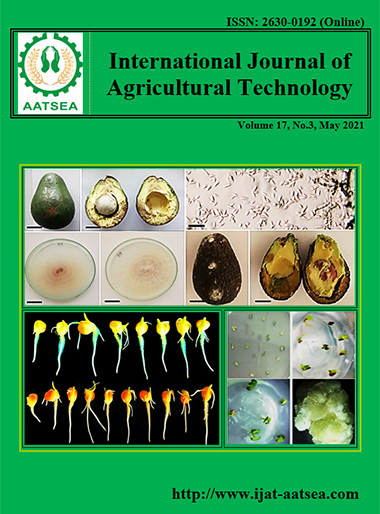Effect of production process on physicochemical properties and bioactive compound in Karanda (Carissa carandas) tea
Main Article Content
Abstract
Karanda flesh consisted of 85.89± 0.38% moisture, 0.88± 0.17% ash,1.76± 0.22% crude protein %, 3.41±3.79% crude fat 1.41 ± 0.43% crude fiber, 6.65 ± 3.65% carbohydrate, 120.16±0.31 mg GAE/g total phenolic content, 72.10±0.65% DPPH antioxidant activity, 3.26±1.75 mg TE/g ferric ion reducing antioxidant power (FRAP) assay, 466.65±2.25 mg/g total anthocyanins. The study of different temperatures for roasting and rolling (40-50,50-60,70-80 °C), rolling time (10-20 min), and drying temperature (60 and 80 °C) on the production of Karanda tea affected moisture content, total phenolic content, antioxidant activity, ferric ion reducing antioxidant power and total anthocyanins in Karanda tea (p≤0.05), the roasting-rolling and drying at higher temperatures affected an increase in the bioactive compound. As a result, the tea production formula containing the most bioactive compound content drying at 80 °C to study the amount of water (80 and 90 ml) and water temperature (70 and 90 °C) for making tea. The amount of water and water temperature had no effect on the bioactive compound (p>0.05). The result of sensory testing by 50 panelists using a 9-point hedonic scale found that difference preference scores to appearance and color (p≤0.05) but not a significant difference in terms of taste and overall liking for Karanda tea (p>0.05). Thus, the appropriate formula for Karanda tea making was 1 g of tea, 80 ml of water and 90 °C water temperature
Article Details

This work is licensed under a Creative Commons Attribution-NonCommercial-NoDerivatives 4.0 International License.
References
AOAC (2000). Official methods of analysis. Association of Official Analytical Chemists, Washington, DC.
Arslan, D. and Ozcan, M. M. (2010). Study the effect of sun, oven and microwave drying on quality of onion slices. LWT - Food Science and Technology, 43:1121-1127.
Buachun, N. (2018). Antioxidant activity and total phenolic from seeds and fruits of Carissa carandas. Journal of Research and Development, Valaya Alongkorn Rajabhat University under the Royal Patronage, 13:53-63.
Burits, M. and Bucar, F. (2000). Antioxidant activity of Nigella sativa essential oil. Phytotherapy Research, 14:323-328.
Fakngoen, S. and Meerod, S. (2017). Extraction and separation of anthocyanins from Carissa carandas L. The Vth Kamphaeng Phet Rajabhat University National Conference, 1011 p.
Gupta, P., Bhatnagar, I., Kim, S. K., Verma, A. K. and Sharma, A. (2014). In-vitro cancer cell cytotoxicity and alpha amylase inhibition effect of seven tropical fruit residues. Asian Pac Journal of Trop Biomed, 4:S665-S671.
Hsu, L. C., Hurang, L. S., Chen, W., Weng, M. Y. and Tseng, Y. C. (2004). Qualities and antioxidant properties of bread as affected by the incorporation of yam flour in the formulation. International Journal of Food Science & Technology, 39:231-238.
Itankar, P. R., Lokhande, S. J., Verma, P. R., Arora, S. K., Sahu, R. A. and Patil A. T. (2011). Antidiabetic potential of unripe Carissa carandas Linn. Fruit extract. Journal of Ethnopharmacology, 135:430-433.
Khonsarn, N., Chaiyabot, A., Chairak, N. and Lawan, S. (2018). Effect of drying on total phenolic contents and antioxidant activities in herbal infusions. Journal of Khon Kaen AGR, 46:1395-1400.
Kubola, J., Siriamornpun S. and Meeso, N. (2011). Phytochemicals, vitamin C and sugar content of Thai wild fruits. Journal of Food Chemistry, 126:972-981.
Langley-Evans, S. C. (2000). Antioxidant Potential of Green and Black Tea Determined using the Ferric Reducing Power (FRAP) assay. International Journal of Food Science and Nutrition, 51:181-188.
Luemchan, D., Chantrapornchai, W. and Haruathaithanasan, V. (2008). Extraction of anthocyanin from black glutinous rice. 46th Kasetsart University Annual Conference: Agro-Industry, 677 p.
Maheshwari, R., Sharma, A. and Verma, D. (2012). Phyto-therapeutic Significance of Karaunda. Bulletin of Environment, Pharmacology and Life Sciences, 1:34-36.
Nanthachai, N., Monnamorn, S. and Panate, K. (2013). Effect of processing on antioxidant activity and total phenolic content of pummel peel tea. The Journal of Agricultural Science, 44:221-224.
Noosing, S., Mundee, P. and Leelawat, B. (2014). Development of instant germinated purple rice tea. Journal of Science and Technology, Thammasat University, 22:337-346.
Othong, J., Thongtun, J. and Limsuwan, T. (2015). Development of Yanang herbal tea and its physicochemical properties, antioxidant activity and total phenolic compound. 53rd Kasetsart University Annual Conference: Plants, Animals, Veterinary Medicine, Fisheries, Agricultural Extension and Home Economics, 1595 p.
Pewlong, W., Sajjabut, S., Singphet, S. and Eamsiri, J. (2013). Influence of fruit ripening stages on the bioactive compounds of Carissa carandas L. The Journal of Agricultural Science, 44:334-340.
Phosee, N., Khongbutr, P., Uttamating, K. and Rittichai Assawarachan, R. (2013). Effect of temperature on moisture ratio and color changes on mint leaves during hot air drying process. Journal of Rajamangala University of Technology Suvarnabhumi, 1:103-114.
Simla, S. (2016). Carissa carandas L.: The fruit mentioned in Thai literature that has many health benefits. Journal of Khon Kaen AGR, 44:557-566.
Simla, S., Boontang, S. and Siritrakulsak, P. (2013). The evaluation of some phytochemical content and antioxidant activity in Carissa carandas L. Journal of Khon Kaen AGR, 41:602-606.
Thai Industrial Standards Institute (2013). Community product standard, mulberry leaf tea 1446/2556. Ministry of Industry. Bangkok.
Theppakorn, T. (2012). Tea (Camellia sinensis L.): Manufacturing and chemical compositions from fermentation. Burapha Science Journal, 17:189-196.
Wrolstad, E. R., Dust, W. R. and Lee, J. (2005). Tracking color and pigment changes in anthocyanin products. Trends in Food Science & Technology, 16:423-428.
Vashisth, T., Vashisth, R. K. and Pegg, R. B. (2011). Effects of drying on the phenolics content and antioxidant activity of muscadine pomace. LWT - Food Science and Technology, 44: 1649-1657.


